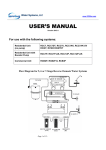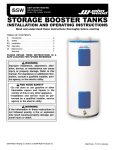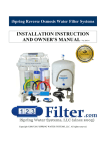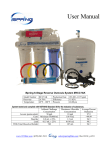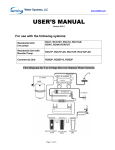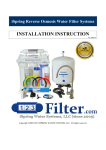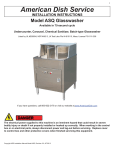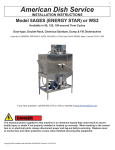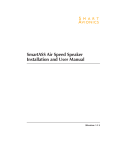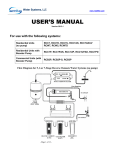Download USER`S MANUAL Model #RCB4T
Transcript
Water Systems, LLC www.123filter.com Email: [email protected] TANKLESS REVERSE OSMOSIS SYSTEMS USER’S MANUAL Model #RCB4T ABOUT THE SYSTEM Reverse Osmosis process is a separation process. Tap water enters the system, and it is separated at the 4th stage membrane filter. One side would go to the faucet (purified water); the other side carrying all the minerals is purged to the drain. The drain is required for the RO process to work. If the drain is intentionally shut off, all the minerals will be accumulated inside the membrane, and it would permanently damaged the membrane filter. All Reverse Osmosis units require purging of water when it’s producing water. . The drain will shut off automatically when the faucet is shut off and the system is not making water. PRODUCT SPECIFICATION iSpring Reverse Osmosis Tankless System Capacity: Generates 300-400 gallons per day depends on water temperature, pressure, and chemistry variations. System includes • RO unit: 5-stage unit, all filters included. • Water Dispensing Faucet: Non-air gap, lead-free, long reach goose neck type, chrome steel, locking lever for continuous dispensing. • Hardware: feed water adapter, feed water valve, drain saddle valve, tubing, wrenches, and screws. • Installation & Service manual System Requirements • Working pressure: 35 to 72 psi feed water pressure required. If the input pressure is above 80 psi, you MUST put a pressure regulator to reduce the pressure below 80 psi. • Working temperature: 100 ~ 40 deg. F ( 37 ~ 4 deg. C ) • pH range: 3-11 • If feed water has hardness level above 300 ppm, we recommend putting a water softener prior to the RO system. • If feed water has iron, rust problem, we recommend putting an iron filter prior to the RO system. • If feed water has bacteria problem, we recommend to add an ultra violet sterilizing filter to the RO system. Filter Service Life Filtration Stage Filter 1st Stage Sediment filter Recommended Changing Frequency Every 3~6 months 2nd Stage Replacement Filter Part No. FP15 GAC carbon filter Every 6 months FG15 rd Carbon block filter Every 6 months FC15 th TFC/TFM membrane Every 24 months MC2 (2 Pieces) th Inline carbon filter Every 12 months FT15 3 Stage 4 Stage 5 Stage Dimension • RO unit: • Faucet: Length 15 inch, Width 11 inch, Height 17.5 inch 9 ½ inch above counter top Warranty • 1 year Limited Warranty on parts, components. Filters are not under warranty. Performance • Rejection rate: 85 to 95% of dissolved solids after RO depending on source water quality, pressure, temperature, and etc. Thank you for choosing iSpring Reverse Osmosis Water Systems. You now own a superb Tankless Reverse Osmosis (RO) System that effectively reducing most contaminants, organic and inorganic compound, unwanted taste and odor from tap water. It is designed to transform your tap water into crispy clean drinking water. Read carefully and follow the instruction in this manual before proceeding with actual installation. Failure to do so could result in personal injury or damage to the equipment or other properties. Be sure to follow any special plumbing codes in your area. RECOMMENDED TOOLS LIST Variable speed drill 5/8, 9/16 open-end wrench, or adjustable wrench, pliers Utility knife, or scissor 1/8” ¼”, 7/16”, ½”, and 5/8” drill bit Phillips screwdriver Teflon tape WARNING: Do not use this RO+DI system alone to treat water with bacteria problem or water source with unknown quality. WARNING: Do not connect HOT water source to this unit. WARNING: Incorrect installation will VOID the warranty. WARNING: Input pressure must not exceed 80 psi. Pressure regulator must be installed to reduce pressure. WARNING: Using other brand of replacement filters and parts will void the warranty. 2 INSTALLATION DIAGRAM INSTALLATION (FOR UNDER-THE-SINK INSTALLATION) STEP 1: TAPPING INTO COLD WATER SUPPLY CAUTION: The water supply to your RO unit MUST come from COLD water line. Hot water will damage your RO system. 1. 2. 3. 4. Locate cold water shut off valve under the sink and turn it off. Open cold-water faucet to release the pressure, and make sure there is no water. Put 3 turns of Teflon tape on threaded ends of the angle needle valve, or the ball valve. Determine the best location for putting the feed water adapter. Do you have a flexible line or a solid copper tube? Is the flexible line with smooth surface or spiral line? Is there enough space for installing feed water adapter? More radius or more space is required if you first joint the feed water adapter with the needle valve. Is the size of fitting thread the same as the feed water adapter? You can either joint the angle needle valve to the feed water adapter first, or install adapter to cold water supply line first. It depends on how much space is available under the sink. 3 5. 6. 7. 8. For FLEX line: Loosen nut and separate cold water riser tube from faucet shank. Gently bend riser tube so that feed water adapter fits onto faucet shank. Use the Existing cone washer (if the existing cone water is badly damaged, use the new cone water provided in the kit). NOTE: If you have a spiral type flex tube riser, you NEED to use the existing cone water, since the cone washer we provided is straight, not spiral). Use Teflon tape on threaded parts to prevent leaks. Then tighten the connection. For Solid Copper riser: Same procedure as flex tubing except you must cut a piece of the riser tube about 3/ 4” to 1” so the adapter can fit between faucet and riser tube. Use Teflon tape to prevent leaks. Install the angle needle valve to adapter if you have not done so in procedure #4. For connecting red tubing to angle needle valve, refer to the photo below. Then push tubing through the brass nut, then the sleeve, then put plastic insert inside the tubing, then push sleeve against the insert, then screw on the brass nut. Don’t over tighten it. But it has to be tight. • • • 1. Feed water adapter ½ “ connect to base of kitchen faucet 1. 2. 3. 4. Buy a ½ pipe to ½“ pipe hose ½ to ½” nipple fitting. Adapter Your existing faucet pipe Many times, it is easier to use the existing cone washer than using the new one If there is not enough space on the sink base, or it’s difficult to get to, you can disconnect the riser from the cold-water valve side. If the fitting size does not match, buy size-changing fittings, or buy a new flex riser with matching sizes Many times, it is easier to buy an additional stainless steel braded flex riser and a ½“ nipple to put in between the bottom of the faucet male thread and the feed water adapter (Don’t buy the spiral type) so you can easily put the feed water adapter between two risers. This is the EASIEST way. Spend additional $5 on the riser may save you a lot of time. Feed water adapter with Ball valve 1. 2. 3. 4. put Teflon tape on the thread, put only 3 turns push tubing through the nut, push tubing all the way into the connection, screw on the nut tight using a wrench NOTE: For systems using compression fitting connections: When connecting tubing to the system, first, you must unscrew the compression nut off the fitting, then pass the tubing through the compression nut about 1”, then screw on to the fitting, then use a 5/8” wrench to tighten the nut until the thread is not visible. Don’t over-tighten it. For systems using quick-connect fitting connections: Insert the tubing into the fitting until it stops. Make sure the blue U-shape saddle piece is on the fitting. This piece locks the tubing and prevents it from slipping off. To remove the tubing off the quick fitting, remove the blue U-shape saddle first, push in the quick-connect fitting, then pull out the tubing. 4 STEP 2: INSTALLING THE DISPENSING FAUCET 1. 2. faucet base small washer + chrome plate 3. large washer 4. kitchen sink 5. bottom plate 6. lock washer 7. lock nut 8. tube insert 9. sleeve 10. faucet nut drill 5/8” hole on the sink The faucet should be positioned with aesthetics, function and convenience in mind. An ample flat surface is required for the faucet base so that it can be drawn down tight. Also check the under sink area of the desired location to see if there is ample space to complete the faucet installation. If the space is not available on the upper sink area, the faucet could be positioned on the counter top at the edge of the sink. Be sure to watch for obstructions below, i.e., drawers, cabinet walls, support braces, etc. If the counter top is ceramic tile, the method for drilling the hole should be the same as for porcelain sink. NOTE: The sink drilling process, although not complicated, requires a certain amount of caution and forethought. Porcelain sink can chip if care is not exercised. PORCELAIN ENAMEL SINK/ STAINLESS STEEL SINK/ ALUMIUM SINK A 5/8” hole is required for the faucet. It is recommended that you get special drill bit for porcelain and tile counter. 1. 2. Place a piece of masking tape or duct tape on the determined location where the hole is to be drilled. Use a variable speed drill at slow speed with 1/8” drill bit, and drill a centering hole in the center of the desired faucet location. 3. Enlarge the hole using a 1/ 4” drill bit. 4. Enlarge the hole using 7/16”, 1/ 2”, and 5/8” drill bit. Pause occasionally to cool drill bits. 5. File or clean the surrounding area and remove the masking or duct tape. (NOTE: the metal chips on porcelain will stain very fast) 6. DON’T put Teflon tape at the tip of the threaded mounting base of the faucet since it’s a compression fitting. 7. Put the small rubber washer, the chrome base plate, large rubber washer according to the diagram through the threaded mounting tube at the base of the faucet. 8. From under the sink, install the bottom plate, lock washer, and nut. Then screw on tightly. 9. According to the diagram, put the brass nut through the BLUE tubing first, then plastic sleeve (preferred), or brass sleeve, then the plastic insert. Push the white plastic sleeve against the insert. 10. Screw on the Blue tubing with brass nut to the faucet base. Uses wrench to tighten the nut but don’t over tighten it. Too tight would cause leak. 11. The spout can swivel 360-degrees. The faucet lever can be pushed down for dispensing or pulled up for continuing dispensing. STEP 3: MOUNTING THE DRAIN SADDLE VALVE (don’t put in blue area) The drain saddle valve should fit most standard drain pipe. It should be installed above the trap and on the horizontal pipe (1) or vertical pipe (2). DON’T put on position (3), (4), or blue section -Position the drain saddle in desired location, mark spot. You need to consider available space for drain tubing. -Drill 1/ 4” hole into the drainpipe above the water line of the pipe. Clean the surface of the pipe. -Pear off the sticky foam pad, then align the center hole around the drilled pipe hole. Then tape it. 5 Align the drilled hole in the drain pipe with the drain saddle using a drill bit or narrow screwdriver Put the complementary piece and clamp them together with the two bolts. (1) Tighten the two bolts evenly (2) Connect tubing STEP 4: TUBE CONNECTIONS It is recommended to provide generous length of tubing during installation (except drain tube). This will make future servicing and filter changing easier. Tighten all fittings firmly by hand then 1 1/2 to 2 full turns with a wrench. Don't over do it and strip the plastic threads. 1. Supply Tube Slide the tube through nut on the water supply connector and then slide on plastic ferrule with the tapered end facing the seat on the fitting. Then firmly insert the tube into fitting on the feed water tap valve. Tighten firmly with a wrench. Cut the tube to length to reach the RO system. Use a razor blade to cut the tube. Be careful to make a smooth, flat, square cut. Do not crush tube. Using the above procedure, connect the other end to the water inlet (this is the first filter housing that holds the sediment pre filter). This is the connector on the side of the filter housing that does not already have a tube hooked up to it. Tighten firmly. 2. Faucet Tube Connect the tube to threaded connector on the bottom of the faucet. This is the center post of the faucet. Use supplied brass hex nut and plastic ferrule. Cut to length and connect the other end to the post filter (L elbow). Tighten firmly. 3. Drain Tube - Non-Air Gap Faucet Connect one tube to the RO system drain fitting. This is the fitting on the loose line behind the RO membrane housing. Tighten firmly so tube will not pull out of fitting. There is a small cylindrical flow restrictor in this line that will help identify it. Cut tube to length and connect the other end to the drain saddle that you installed earlier. Tighten firmly. STEP 5: SYSTEM START-UP 1. 2. 3. 4. 5. 6. 7. Make sure all tubings are not kin ked. Plug in the electricity for Booster pump. Turn RO faucet lever to continuous flow position. Lever points up or turn counter clock-wise for upgraded faucets. Turn cold water supply main valve on slowly. When the system is pressurized, check for leaks. If a leak is found, tighten the connection. Wait for 10-15 minutes to allow water to flow through the system, and air inside the system can be purged. Then the water should start dripping out of the RO faucet and at first may be black. Let water drip out of faucet for 30 full minutes and then close faucet. This flushes the carbon filters on first time use. Close the sink top faucet, check if the system stops working and if the solenoid can shut off the water supply. Turn on the RO faucet again to see the system starts running and the HP switch repositions itself. Now, the system is ready for use. Job Well Done! **NOTE: Check for leaks daily for the first week after installation.** 6 CHANGING FILTERS PROCEDURES • • • • • • • • • Shut off the system by turning off the water supply, open the spigot to depressurize Prepare a towel under the unit for water spills Use a filter wrench (part no. 566) or use hands to open the filter housing, unscrew it from right to left. To open is clockwise looking from the top. Throw away the used filter, and clean the inside of the housing by rinsing or scrubbing it with dish soap. Check condition of the O-ring. It should be replaced every 3 years to prevent leak Place the new filter inside the filter housing. For carbon filters, the rubber gaskets should be on both ends. Put some Vaseline or silicon-based O-ring lubricant on the side of the housing thread and the O-rings (optional procedure) Use a filter wrench or both hands to screw the housing back by turning it from left to right (Don’t lay down the unit when turning it, the unit should be standing upright to prevent the o-ring or filters from misalignment) Repeat the above steps for other filters REPLACE INLINE CARBON FILTER / DI FILTER /ALKALINE FILTER • • • • * if you have compression fitting For inline carbon filter, remove fittings from both ends of the filter then replace new filter. After all housings are tight, turn on the water Check for leaks, if there is a leak; tighten the housing or re-aligning the o-ring. Open the faucet for 30 minutes to flush new *unscrew fitting off to replace filter CHANGING MEMBRANE PROCEDURE • • • • • • Lift the membrane housing from the U-clips, and remove the tubing from the membrane fitting (the inlet side of the membrane housing, or the side with the membrane housing cap). Unscrew the membrane housing cap off (counterclockwise) Use pliers to pull the membrane out of the membrane housing, and discard the used membrane. Put some Vaseline or lubricant on the small black O-rings. Insert the new membrane into the membrane housing (THE SIDE WITH DOUBLE BLACK O-RINGS SHOULD GO IN FIRST) Push the membrane all the way in (some force is required to make sure the membrane is all the way in). Put some Vaseline or silicon based lubricant to the side of the housing threads. Screw the membrane-housing cap back (clockwise). Make sure O-ring is in place. Connect the tubing to its elbow fittings. Turn on the faucet, then turn on the water supply to restart the system. Check for leaks, if there is a leak, tighten the cap Open the faucet to flush the system for 30 minutes for new membranes. 7 LIMITED ONE-YEAR WARRANTY 1. What your warranty covers: iSpring Reverse Osmosis Systems are warranted to the original owner to be free of defects in material and workmanship from the date of manufacture for one year as follows: a. Manufacturer will, within one year of purchase, replace the defected parts (excluding filters) at no charge. b. The replaceable filters are not warranted since the service life of replaceable filter varies with local water conditions and thus not warranted. 2. Conditions of Warranty: a. System must be maintained and serviced with the manufacturer original replacement parts and filters. The performance of your drinking water system is directly related to the conditions of the water been treated and the particular application in which it is used. Therefore, manufacturer’s liability is limited to the cost of repair of the RO systems. The manufacturer is not liable for incidental or consequential damages of any kind. Systems must be installed and operated in accordance with manufacture’s recommended procedures and guidelines. 3. What iSpring Reverse Osmosis Systems will not do: a. Warranty is void if product failure or damage results from freezing, neglect, misapplication, fouling with sediment or scale or failure to operate the system in accordance with the instructions contained in this manual. b. The following operating conditions must also be followed for this warranty to be valid The hardness of the water cannot exceed 7 grains per gallon or 120 ppm. No iron can be present in feed water. Or iron should be removed from feed water. The pH of the water must not be lower than 3 or higher than 11 Feed water Total Dissolved solids TDS should not exceed 1000 ppm Feed water temperature between 90 F and 45 F or (32C and 5 C) 4. Obtaining Warranty Service: For Warranty service, obtain a Return Merchandise Authorization (RMA #) number from the manufacture or distributor. You can also contact our technical support department to obtain the RMA # or visit our web site at http://www.123filter.com or email your request to [email protected] 5. Limitations and exclusions: Manufacturer will not be responsible for any implied warranties, including those of merchantability and fitness for a particular purpose. Manufacturer assumes no liability whatsoever for any incidental and consequential damages, including loss of revenue, loss of time, travel expenses, inconvenience, and any damage caused by the equipment and its failure to function properly. 8 Service Record Date of Purchase: ___________ Purchase from: ________________ Reference Order #: ______________________ Date of Installation: _________ Date 1st Stage Sediment (6 months) 2nd Stage GAC (6 months) Installed by: _______________ 3rd Stage CTO (6 months) 4th Stage membrane (2 years) 5th Stage Inline Carbon (1 year) 6th Stage DI (1 year) 6th Stage Alkaline (1 year) 6th Stage UV Lamp (1 year) Please visit our online store at www.123filter.com for all of your future filter needs. Send us an email to [email protected] for any question you have. Better water, better health! 9









